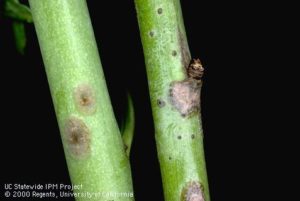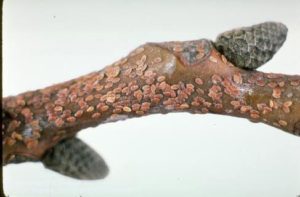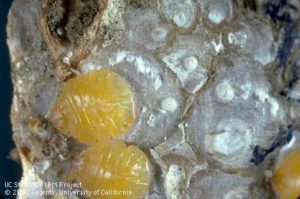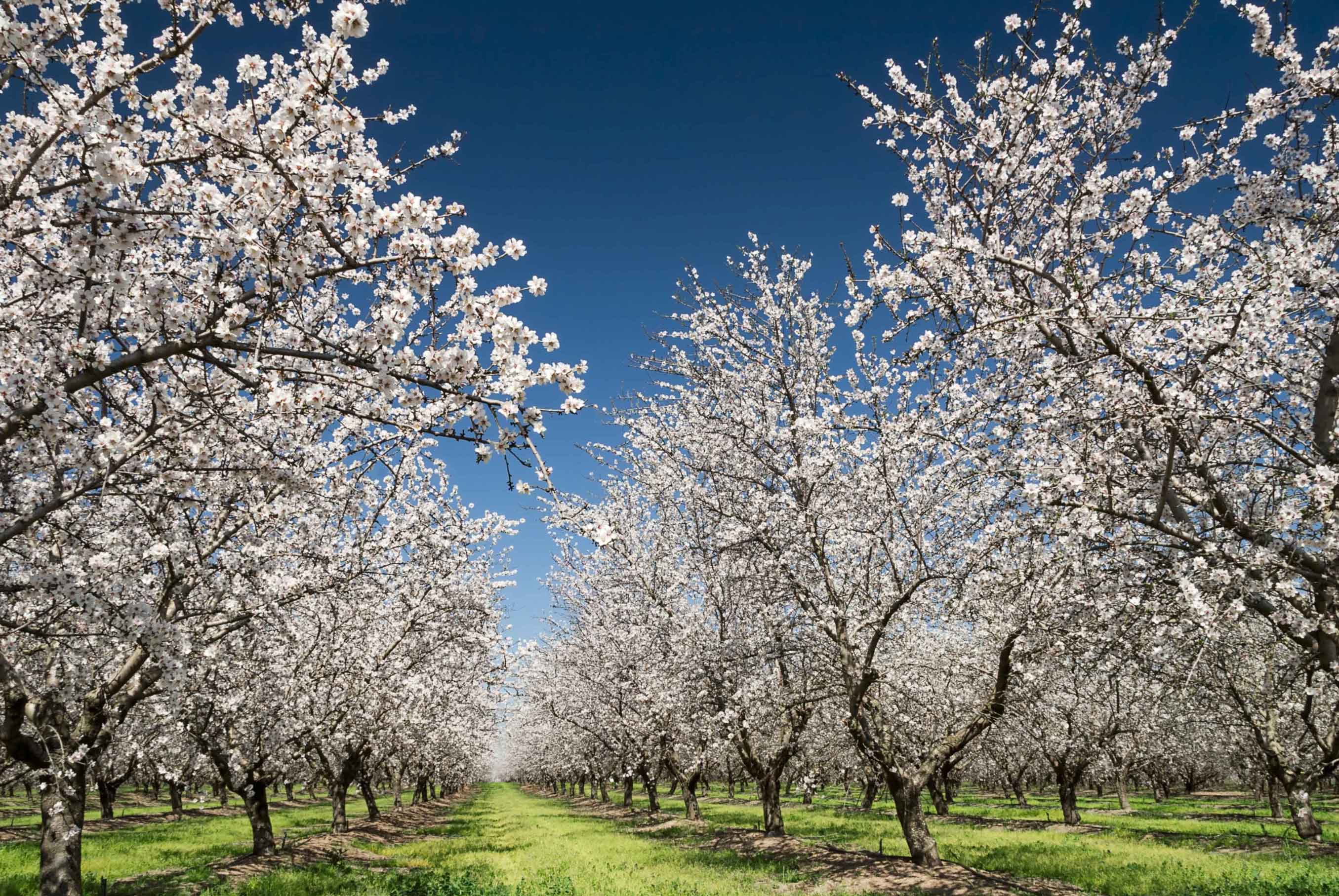With the wild ride of the 2017 growing season now behind us, January is a good time for orchardists to take stock of the key issues of the previous year and begin outlining their production and pest management activities for the upcoming season. During the dormant period, one of the most critical activities that can be done is to sit down with your orchard manager, pest/crop adviser, and your record books to review your pest management history and devise a plan-of-attack for the coming season. Heading into the season armed with lessons learned from successes and failures of previous years, and with strategies on how to deal with potential issues will save time and stress. This will allow you to take a more thoughtful and proactive approach to pest management, as opposed to being reactionary when faced with pest issues that may arise while you are dealing with the myriad of other time-sensitive crop production tasks.
NOW
The “elephant-in-the-room” for insect pest management in nut crops in 2017 was navel orangeworm (NOW). By now you have heard far and wide the damage that was inflicted by this pest to California’s nut crops in the recent harvest. In particular, damage statewide in almonds was significantly higher in 2017, costing the industry millions. You have also surely heard by now, at numerous industry and academic events, the renewed emphasis placed on sanitation efforts targeting this pest in almonds, walnuts, and pistachios. In spite of decades of research confirming sanitation as the single most important baseline activity for reducing NOW damage, sometimes it takes a year like 2017 (when sanitation efforts were largely disrupted by continuous winter rainfall) to remind the industry just how vital this practice is. At a recent conference, the following statement was made, “Sanitation—just do it!” That simple summation is really the key. No amount of sprays or control efforts later in the season can get the low damage result that is desired by your processor if sanitation is not part of the overall NOW management strategy.
Remember that sanitation has a two-fold impact: (1) direct reduction of overwintering populations by increased larval mortality, and (2) reduced egg-laying and development sites of the early spring generations. Therefore, this single management activity sets up the cleanest slate possible in your orchard, and also limits population build-up throughout spring by any that survived the winter in your own orchard or that may be migrating in from surrounding areas.
Knock, shake, or pole nuts during the dormant season, and disc or flail nuts on the ground by the 1st of March. Greater destruction of mummy nuts (almonds and walnuts) = greater mortality and fewer viable development sites (yes, NOW will lay eggs in the spring on mummies on the ground!). Guidelines for almonds suggest that sanitation targets for the southern San Joaquin Valley are fewer than an average of 0.2 mummies/tree and fewer than 8 ground mummies/tree. In the northern San Joaquin Valley and Sacramento Valley, aim for a target of fewer than an average of 2 mummies/tree. Remember that these targets are for the “typical” year. In years with a milder winter, orchards with greater carry-over mummy infestation, or those in close proximity to external sources of NOW, sanitation targets may need to be lower. No thresholds are available for walnut mummies, so use “the cleaner the better” strategy as it works for your particular operation. Remember to focus on areas around the field, huller, etc., where orchard debris is located and thus may play host to overwintering NOW.



In addition to total mummy load in the orchard, mummy infestation is another key piece of information that can provide an indication of the extent of NOW pressure you may be facing in the upcoming year. This, along with additional in-season monitoring measures (trap data, visual observations of egg-laying activity) will help guide your pest management decisions as the season progresses. Post-harvest or during the dormant period, obtain a sample of the mummy nuts in the orchard and evaluate the number of NOW in those mummies. This, coupled with the total mummy load will provide valuable information in predicting the size of the NOW population in your orchard once spring insect activity resumes, and can be a critical piece of the “NOW management puzzle” when deciding if and when treatments are needed. Companies are available that provide mummy “crack-out” services to assist you in evaluating this population measure and what it means for your particular orchard management strategy targeting NOW.
Scale
The rainfall of last winter and spring may have caused some difficulty in applying dormant/delayed-dormant treatments targeting scale pests in walnuts, and dormancy is a good time to head out and get an idea of whether treatments may be warranted in the coming months. In particular, keep an eye out for live walnut scale adults (Photo 2) and frosted scale nymphs (Photo 3). In 2017, a number of orchards reported unusually high populations of frosted scale, while walnut scale incidence seems to be waning, likely due to successful treatments over the last few years. Data suggests that an every two-to-three year rotation of walnut scale treatments is effective in keeping populations low, while allowing natural enemies to provide additional control in the “off” years. For walnut scale, research has shown that dormant/delayed-dormant treatments of insect growth regulators are highly effective. They can also be effectively controlled later in the season after monitoring indicates that crawlers have emerged (typically early May). Research has been initiated evaluating timing and materials specifically for frosted scale, and early results indicate that delayed-dormant insect growth regulators are also effective against this pest. Comprehensive scale monitoring guidelines can be found at: sacvalleyorchards.com/walnuts/insects-mites-walnuts/walnut-dormant-monitoring-and-treatment-decisions/.
Scab
A number of diseases were more prevalent in 2017 due to the high level of winter and spring precipitation. Dormant activities for diseases impacting almond production include monitoring for scab, and possible treatments for scab, bacterial spot, and shot hole. The most important of these activities during dormancy, however, is scab monitoring. Later, more effective treatment timings exist for all three of the disease noted above (dormant treatments for these diseases are only suggested in addition to later timings if disease pressure is severe). Visit the treatment timing table for key almond diseases at: ipm.ucanr.edu/PMG/r3902111.html#TREATMENT.
The fungus that causes scab overwinters in twig lesions, and spores are spread by wind or rain. This disease is worse in wet springs and therefore tends to be more prevalent in the Sacramento Valley. However, with the increased rainfall statewide in 2017, scab outbreaks occurred in orchards typically not affected by the pathogen. As a result, there may be carry-over inoculum in your orchard that should be monitored during the dormant period. A dormant sample can reveal the presence of scab lesions and whether treatment for this disease is warranted. These samples can be done while scouting for other pests, including San Jose scale, European fruit lecanium, and mite eggs (European red mite and brown mite). To sample for scab, randomly select 35 to 50 trees from each orchard or block, and examine at least 40 first-year green twigs for the presence of scab (Photo 1). In severe outbreaks, dormant or delayed dormant applications of liquid lime sulfur, copper + oil, or chlorothalonil + oil may be needed to reduce disease impact. However, in many orchards, spring sprays targeting other diseases (i.e., shot hole) will effectively control the spread of scab. Scab resistance to quinone outside inhibitor fungicides (strobilurins) has been documented, so avoid the use of FRAC mode-of-action group 11 fungicides in orchard with scab. With the use of all pesticides, have a resistance management plan in place ahead of time, so that on-the-spot treatment decisions can be made taking into account your rotational strategy.
Bloom Sprays
Bloom sprays for almond diseases will be right around the corner at press time. Begin thinking now about how you will approach pest management activities when bees are present in the orchard. Follow the Honey Bee Best Management Practices outlined at the Almond Board website (almonds.com/pollination, and links therein). I’ll summarize a few key take-home messages here. First, avoid insecticide applications when bees are present. The only insect pest that can be effectively treated during this time is peach twig borer, and there are other alternate treatment timings that are just as effective. One exception is the use of Bacillus thuringiensis (Bt) during bloom, which has been shown to be relatively bee-safe. Visit ipm.ucanr.edu/PMG/r3300211.html for more information on peach twig borer treatment options and timings. Bear in mind however, that any spray (even just water) contacting active bees can impact their ability to fly. That leads to the second message—fungicide applications are often needed during bloom to protect the crop. There is often no way around these applications when bees are present. To minimize impacts on bees, fungicides should be applied in the late afternoon and evening, when the bees have finished foraging for the day, and with enough time to dry before they become active again the following morning. Be(e) cautious with tank mixes. A wealth of searchable information on the toxicity of pesticides, and mixes of pesticides, to adult honey bees and the developing brood is available online in the University of California Bee Precaution Pesticide Ratings database (ipm.ucanr.edu/beeprecaution/). Maintain communication with all parties involved when bees are present in the orchard and have an agreed-upon plan of which pesticides might be used during this critical time.
The University of California Integrated Pest Management program (UC IPM) has just published the latest comprehensive revisions of the Pest Management Guidelines (PMG) for both almonds and walnuts. These reflect the latest research-based information for managing all types of pests affecting these cropping system (insects, mites, diseases, weeds, nematodes, and vertebrates). The Walnut PMG now includes Botrysosphaeria/Phomopsis, as well as significant updates to walnut husk fly, scale pests, and weeds, among many others. Visit the Walnut PMG at: ipm.ucanr.edu/PMG/selectnewpest.walnuts.html. The Almond PMG now includes bacterial spot, powdery-mildew fruit russeting, a refined weed section, and significant updates to navel orangeworm management and numerous other pests. Visit the Almond PMG at: ipm.ucanr.edu/PMG/selectnewpest.almonds.html.
Best wishes for a successful 2018!
















